
Viz Mosart User Guide
Version 4.1 | Published July 09, 2021 ©
Audio Panel
The Audio Panel is a standalone utility. It visualizes a Behringer BCF2000 or JL Cooper MXL audio mixer connected to the Viz Mosart Server, as a replication of current faders, on air faders, and faders in preview.
Technically, the Audio Panel utility controls data transmission between the physical hardware panel and the AV Automation component on the Viz Mosart Server.
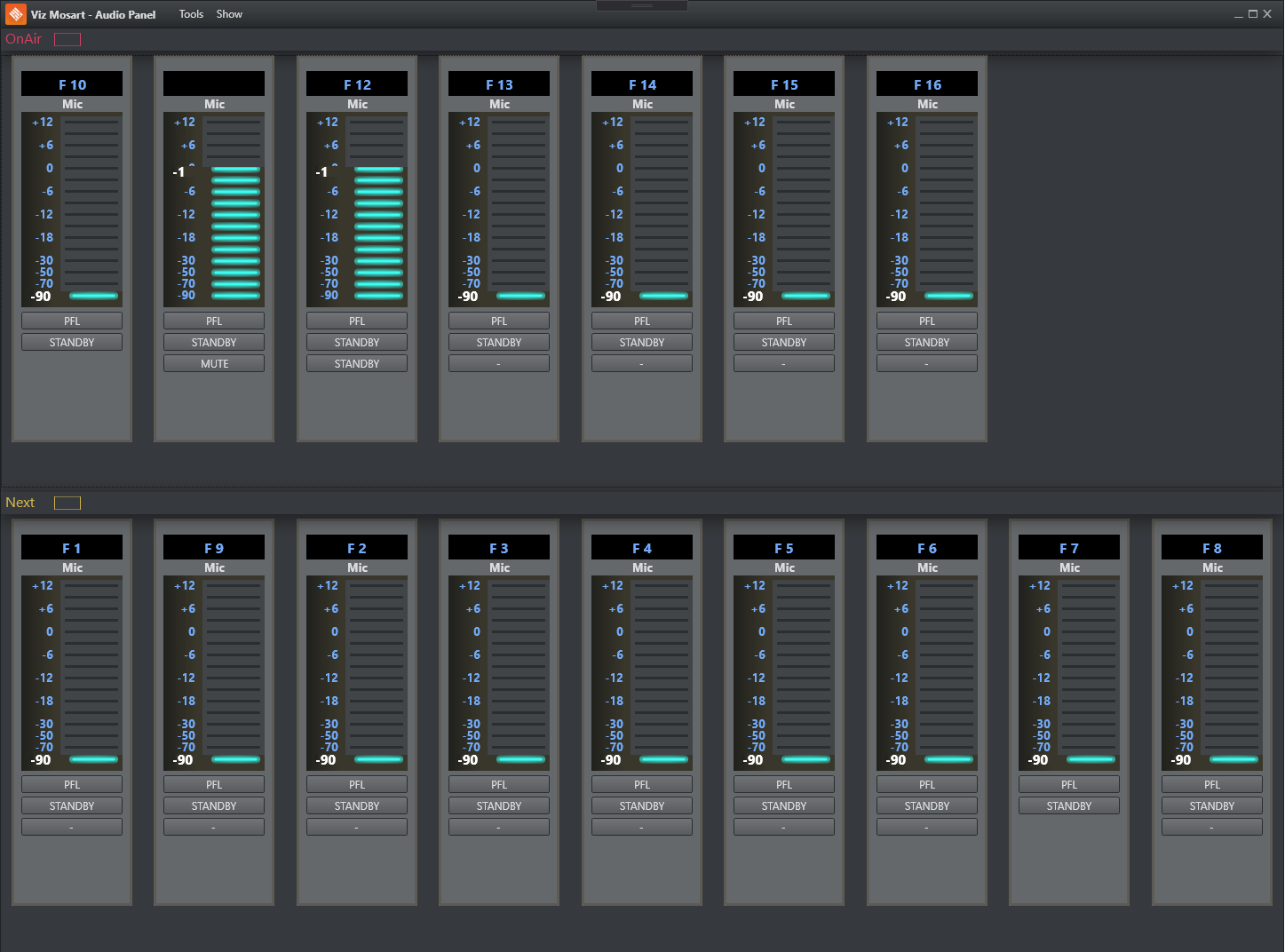
This section contains the following topics:
Setting-up the Audio Panel
There are some once-only setup steps to get the Audio Panel working.
-
Run the software to start the Audio Panel.
Navigate to the Viz Mosart folder C:\Program Files (x86)\Mosart Medialab\Mosart Audio Panel\AudioPanel.exe. -
In Viz Mosart Server select Tools > General settings > Server, to browse Viz Mosart UI's connection settings, that you will also use for Audio Panel.
This is where you tell Audio Panel where to find the server for Viz Mosart. -
You will use the same settings as the Viz Mosart UI.
Must be the same as for a GUI connected to that server.
The Audio Panel requires Manus Administrator and AV Automation to run, as well as a green connection to that Viz Mosart server in the bottom left corner.
Configuration file is located in C:\ProgramData\Mosart Medialab\ConfigurationFiles\ or C:\channeltemplates\. The configuration file is created on startup of Audio Panel if it does not exist.
Here are a small selection of options to properly help you set up your audio fader panel.
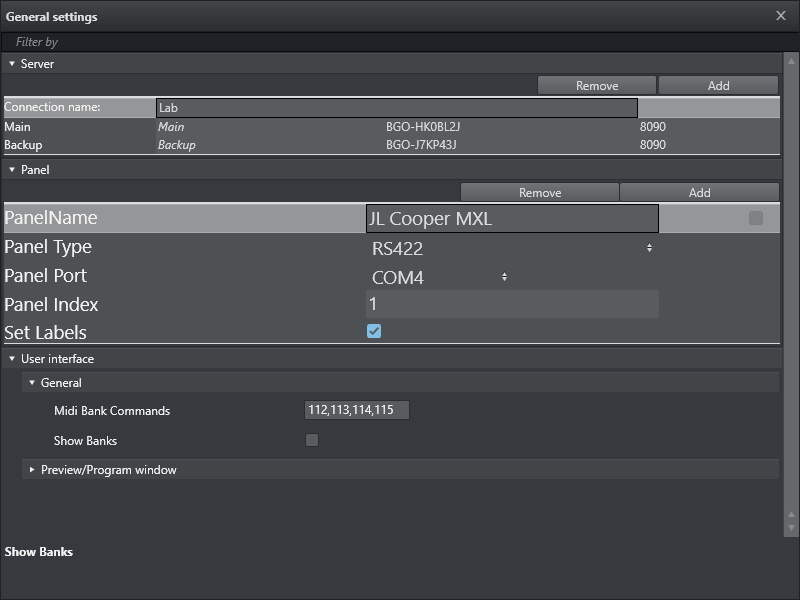
-
Server Settings: Server Name, Server Host and Server Host Backup should be changed/configured for use. You can also change the port that the Application uses to communicate with Viz Mosart servers, the default port is 8090.
-
Panel Settings: The Panel settings consists of the following sub-menus; Panel name, Panel type, Panel Port, Panel Index and Set Labels.
The configuration file is located in C:\ProgramData\Mosart Medialab\ConfigurationFiles\ or C:\channeltemplates\. The configuration file is created on startup of Audio Panel if it does not exist.
Server Settings
|
Item |
Description |
|
Server Name |
This is the name used by the Audio Panel GUI. |
|
Server host |
This can either be the server name OR the IP address + port number. |
|
Server host Backup |
Same as "Server host", for the backup server. |
Panel Settings
|
Item |
Description |
|
PanelName |
A self-administered name for the panel. |
|
Panel Type |
The type of connection used for the audio panel (e.g; MIDI, RS422, RS232). |
|
Panel Port |
The specific port used in the above connection (e.g. COM3). |
|
Panel Index |
You can utilize several panels which could have an individual number. |
|
Set Labels |
Check if you wish to send label information back to the panel, only for panels with LCD label buttons. |
User interface: Use these settings to Bank faders on the JLCooper Panel.
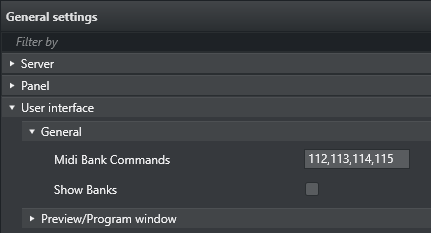
-
Midi Bank Commands: Specifies MIDI controls on the JL Cooper Panel. Default values correspond to F1, F2, F3 and F4 keys.
-
Show Banks: Shows the bank associated with each fader in Audio Panel GUI on the top side for each fader if enabled. The bank for each fader can be changed by right clicking on the fader label and selecting the bank from the displayed pop-up list.
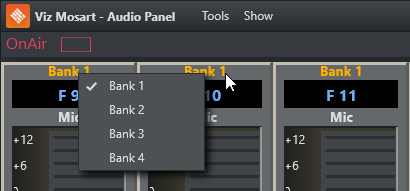
In the Show menu there are options to show MIDI commands and to highlight in orange the selected bank on the faders.
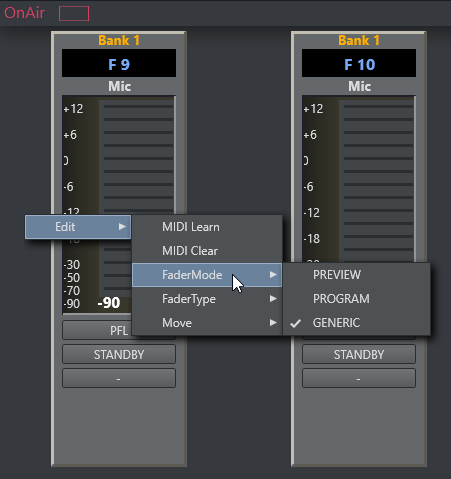
By right-clicking on any fader, and selecting Edit, you can configure properties of the fader’s operation.
Fader Configuration
The fader configuration is reached by right-clicking the fader bar (the box with the numbers indicating the level of the fader).
Fader Edit Menu
|
Menu Item |
Description |
|
MIDI Learn |
Assigns any physical fader on the Audio Remote panel to the selected fader in the Audio panel. After selecting this function, move the fader on the physical mixer so Audio panel learns and memorizes this function. |
|
MIDI Clear |
Deletes the assigned physical fader from the Audio panel. |
|
FaderMode |
Selects whether the logical fader should work in Preview, Program or as a Generic fader which is constantly in use. |
|
FaderType |
Check if you wish to send label information back to the panel. |
|
Move |
Moves the selected fader UP or DOWN in the Audio panel |
Selecting a Source
If you are using the Generic fader mode, a source from the source list can be selected by right-clicking in the area where labels are listed. Check the default number of faders. Input selection can be configured by right-clicking the fader header and selecting fader names. You can select a fader label by right clicking on the label (just below the fader header) and selecting the appropriate function in coordination with your audio mixer.
Note: Selecting "ANY" could remove the label. If no label is present, then the ANY function is the selected label.
To change the label again, right-click in the required fader, Edit > FaderType then select a new label.
Assign Function Keys
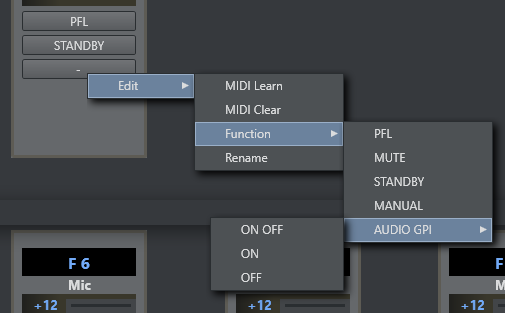
-
Any function buttons below the GUI faders can be assigned to any of the function keys on a physical audio panel.
The function of the button is set under the Function menu. -
The name can be changed using Rename.
|
Menu Item |
Description |
|
MIDI Learn |
Assigns any physical button on the Audio Remote Panel to the selected button in the Audio Panel GUI. |
|
MIDI Clear |
Deletes the assigned physical button from the Audio Panel. |
|
Function |
Select a function for the button. Will be triggered on the fader in AvAutomation. PFL: Activates the pfl mode on the fader. MUTE: Activates the mute mode on the fader. STANDBY: Activates the standby mode on the fader. MANUAL: Activates the manual mode on the fader. AUDIO GPI functionality is only available for Studer 3000 and Lawo RMNOPL drivers AUDIO GPI - ON OFF: Toggles the Audio GPI for a specific GPI number on the mixer. AUDIO GPI - ON: Turns the Audio GPI for a specific GPI number ON. AUDIO GPI - OFF: Turns the Audio GPI for a specific GPI number OFF. |
|
Rename |
Renames the button label |
Update After Viz Mosart Server Switching
The server that the Audio Panel GUI is connected to follows the Viz Mosart GUI, switching between a main and backup server in the Viz Mosart GUI automatically configures the selected server in the Audio Panel GUI accordingly.